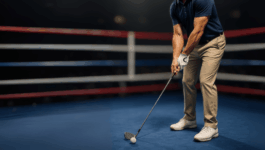For the longest time, workouts never formed a part of a golfer’s training regimen. After all, getting too big and bulky could hinder one’s stroke. Yet attitudes changed when Tiger Woods began his ascent to the top. After revealing he worked out intensely, others began to do the same.
What they found is that working out helped them to both build muscle and improve flexibility. Consequently, these golfers increased the yardage of their golf swings, and you can too!
All you need is consistency and well-targeted golf workouts. You should aim to hit key muscles including the legs, back, shoulders, and chest. Exercises such as squats, shoulder press, and bench press are great for this. And no, you don’t need a gym — although it does help. We’ll break down the best golf exercises both for home performance and the gym. And we’ll finish off with some stretches for you to do at the end.
What Are the Best Exercises for Golf?
While technique is pivotal to a golf swing, the size of your muscles plays a major role in how far you can strike the ball. There are lots of muscles involved in your golf swing, and for an optimal workout, you will want to hit them all if possible. Here are the best golf exercises in our opinion.
- Squats
- Lunges
- Glute bridges
- Push-ups
- Planks
- Bench press
- Seated shoulder press
- Deadlift
- Medicine ball sideways throws
Read More: Best Putting Drills
Best Workout for Golfers at Home
1. Squats
Muscles Worked: Glutes, quads, hamstrings, hips
When it comes to lower-body workouts for golfers, squats are king. They are also very easy to perform without additional weight so anyone can give them a go. However, if you want to make them harder at home, you can always try jump squats or single-leg squats (pistol squats) instead.
How to Perform
- Position your feet around shoulder-width apart.
- Cross your arms and touch your shoulders or extend them out in front of you.
- Keep your back straight.
- Squat down until your knees have at least a 90-degree bend, go lower if you like.
- Ensure that your knees do not extend too far over your toes.
- Push back up and squeeze your glutes at the end of the movement.
2. Lunges
Muscles Worked: Glutes, quads, hamstrings, calves
Lunges are another great exercise that you can do at home, and there are lots of variations to choose from. To keep things simple, we’ll stick with standard lunges.
How to Perform
- Position your feet around hip-width apart.
- Take a large step forward with one leg.
- Bend around 90 degrees at the knees. In doing so your rear heel will come off the ground.
- Push off your lead leg to straighten both legs.
- Repeat steps 3 and 4 for the desired number of reps.
- Switch legs to work out the other side.
3. Glute Bridges
Muscles Worked: Glutes, hamstrings, abs
Glute bridges are a more targeted exercise than squats and lunges as they heavily work the glutes. That being said, the hamstrings and abs do come into play as well.
While squats and lunges are dynamic exercises, glute bridges can serve as both a dynamic or a static exercise. If you lack additional weight at home, static glute bridges may well be the superior option as you have more time under tension.
How to Perform
- Lay on your back with your knees bent around shoulder-width apart, your heels on the ground, and your arms by your sides.
- Contract your glutes and thrust your hips upward, forming a straight bridge from your knees to your shoulders.
- For static glute bridges, hold this position, and for dynamic, lower your hips back to the ground and repeat step 2.
4. Push-Ups
Muscles Worked: Chest, shoulders, triceps, abs
Push-ups really get too much stick as they are a great exercise. They mostly get criticism because standard they are far too easy for individuals with muscular upper bodies. However, push-ups have far more variations than most other exercises. While we will describe how to perform a regular push-up. Here are some variations you may want to try:
- Wide grip push-ups
- Diamond push-ups
- Pike push-ups
- Archer push-ups
- One-arm push-ups
How to Perform
- Adopt a push-up position with your elbows straight and your hands flat on the ground beneath your shoulders.
- While engaging your core and keeping your back straight, descend until your chest is around 5 inches from the ground.
- Keep your elbows tucked in close to your body, and push off the ground to lock out your elbows.
5. Planks
Muscles Worked: Abs, chest
Planks are our exercise of choice to hit your abs. Unlike the exercises discussed thus far, planks are exclusively a static exercise. Like glute bridges, they are highly targeted. They work out a range of abs muscles such as the rectus abdominus and external obliques.
While many places claim that they hit a variety of other muscles such as the traps and triceps, this is to a very small extent and isn’t worth mentioning.
How to Perform
- Adopt a push-up position but place your forearms on the ground rather than your hands.
- Hold this position so that your body forms a straight line from your legs to your shoulders.
Read More: Golf Drills
Best Golf Workouts For the Gym
1. Bench Press
Muscles Worked: Chest, shoulders, triceps, biceps
While building a bigger chest won’t increase your swing speed as much as hitting other muscle groups, it’s still damn important. And no exercise is better for building the chest than the bench press.
Bryson DeChambeau benches a respectable 275 lbs and Brooks Koepka edges him with 315 lbs.
How to Perform
- Lie back on a bench and position your head beneath the bar.
- Grab the barbell with an overhand grip that is at least shoulder-width apart (more if comfortable).
- Inhale and unrack the bar. Straighten your arms and move the bar so that it is above your lower chest.
- Lower the barbell so that it touches your chest.
- Push outwards and straighten your arms, exhaling as you do so.
2. Seated Shoulder Press
Muscles Worked: Shoulders, traps, triceps
Where the bench press is king for the chest, the shoulder press is king for the shoulders. As we know, the shoulders play a key role in our golf swing, so building up strength here will prove fruitful.
How to Perform
- Take a seat on an upright bench and rest the dumbbells on your thighs.
- Using an overhand grip, one at a time raise the dumbbells to just above your shoulders (lift your knees to help get them to this position).
- Extend the dumbbells upwards and lock out your elbows.
- Be careful not to clink the dumbbells together at the top.
- At the bottom of the exercise, the dumbbell bars should be at around chin level.
3. Deadlifts
Muscles Worked: Glutes, hamstrings, back, abs, hips, lats, traps
Deadlifts are one of the best compound exercises for golfers because they almost exclusively hit the muscles that are important for a golf swing.
We would just advise caution when performing them, as it is very easy to injure yourself if you perform deadlifts incorrectly.
Also, deadlifts are very taxing on the body, so ensure you take enough time to rest. Where for most other exercises you will aim for 8-12 reps, with deadlifts, 1-6 reps is standard as they are an exercise for golf strength.
How to Perform
- Stand just behind the barbell with your feet shoulder-width apart.
- Puff out your chest and bend at the knees and lower your hips until you can grip the bar.
- Grab the bar with a mixed grip, one hand overhand and the other underhand.
- Maintain a straight torso and head throughout the movement.
- Drive into the ground and straighten out your legs and push your hips forward.
- Reverse the movement to allow the bar to hit the ground.
4. Medicine Ball Sideways Throws
Muscles Worked: Shoulders, obliques, abs, glutes, hips
While medicine ball throws are far from a staple in the gym, we think they are great for golfers. This is because they engage your fast twitch muscle fibers which is perfect for the explosiveness of a golfer’s swing.
Of the few people you do see doing medicine ball throws, most will be performing them from overhead, slamming the medicine ball straight into the ground. However, we think sideways throws are much better for golfers to emulate the rotation of a swing.
How to Perform
- Find a sturdy wall and stand to the left or right of it.
- Position your feet a little wider than shoulder-width apart.
- Pick up the medicine ball and grip it firmly with both hands.
- Retract the medicine ball past your rear hip keeping it below your shoulders.
- Turn forcefully and slam the ball into the wall.
- When you’ve worked on one side turn 180 degrees to work the other.
Stretches For Golf
Although not many people do it, stretching after a golf workout is a good idea as it helps with muscle tightness and increases flexibility which will help with your golf swing.
1. Behind the Shoulder Stretch
Targets: Shoulders
This one is great for loosening up your shoulders and preventing rotator cuff injuries.
How to Perform
- Position your feet shoulder-width apart.
- Grab a large dowel or golf club with an overhand grip.
- Elevate it over your head and keep your elbows straight.
- Try to push the dowel/golf club back as far as you can.
2. Toe Touches
Targets: Hamstrings and calves
Toe touches are a common stretch for the hamstrings and calves. You don’t need any equipment for this exercise as you’re just touching your toes!
How to Perform
- Position your feet shoulder-width apart.
- While keeping your legs straight, bend over and try to touch your toes.
3. Standing Quad Stretch
Targets: Quads
Standing quad stretches are another common lower body stretch that you’ll see almost any sportsman use.
- Position your feet shoulder-width apart.
- Balance on one foot and grab your other ankle and pull it behind your glute.
- Try to keep your bent leg in line with your straight leg.
- Squeeze your abs to prevent pelvic tilt.
- Switch legs to stretch your other quad.
4. Standing Oblique Twists (Obliques)
Type: Dynamic
Keep hold of your golf club for our next exercise: the standing oblique twist. This exercise predominantly targets the oblique muscles, although you should also feel a good stretch in your abs, back, and lats.
- Stand with your feet shoulder-width apart
- Place your golf club, so it rests on your trapezius muscle and grab either end of your club
- Turn around 90 degrees to the right until you feel a good stretch (careful not to move too quickly, or you could overstretch)
- Return to the middle and turn to the left around 90 degrees to stretch the other side.
5. Standing Back Extensions (Back)
Type: Passive
Standing back extensions are a great way to get your back working.
- Stand with your feet shoulder-width apart
- Position your hands in the small of your back
- Push your hips forward and arch your back
6. Arm Circles (Shoulders)
Type: Dynamic
Arm circles are my favorite form of dynamic stretching, and I do them before playing almost any sport. They are great at getting the blood pumping through your arms and working your shoulders.
More specifically, they target your rotator cuffs, a common place to get injured, so arm circles are great to implement into your warm-ups. They also target the biceps and triceps to a much lesser extent.
- Stand with your feet shoulder-width apart
- Begin with your arms in line with your shoulders and perform small circular motions in an anti-clockwise rotation
- Gradually widen the circle’s circumference until your hands overlap
- Repeat the process in the opposite direction with clockwise rotations
7. Wrist Flexor Stretch (Wrist and Elbow)
Type: Passive
This stretch is a two-for-one kind of deal. While it’s most apparent that the stretch targets your wrists, it’s also one of the best golf stretches for tackling a golfer’s elbow. So do yourself a favor and start doing it!
- Seated or standing, have one arm out straight in front of you
- Raise your fingers as if you are telling somebody to stop
- Using your other hand, pull back on your fingers to get a better stretch
- Swap the roles of your arms and stretch the other side
8. Low Lunge (Hips, Quads, Groin)
Type: Passive
As golfers, we know how involved our hips are when executing a swing, so they need good warming up. Our choice of hip stretch is the low lunge. It gives you a great stretch on the hips and works out a variety of other key muscles, such as the quads, groin, and back.
- Adopt a standard lunge position with your right leg forward and drop your left knee to the ground
- Your right knee should be bent and over your right foot
- Force your hips downward
- Raise your arms overhead and stretch back as much as is comfortable
- Switch legs and stretch the other side.
Read More: How to Practice Golf at Home — 6 Steps to Practicing at Home
FAQs
Should I Work Out Before My Round?
Working out before golf is only a good idea if it is a very light session. You shouldn’t go into your round fatigued. We recommend only a light warm-up and stretches. Leave your heavy lifting for another day.
What Muscles Should You Work Out For Golf?
Golf uses a variety of muscles including the glutes, hips, back, traps, and shoulders. You should train all of these muscles if you want to improve the distance of your golf swing.
Is Hitting Golf Balls Good Exercise?
Hitting golf balls is an okay form of exercise. If of course burns calories, but you’ll burn far more doing a full 18 rounds. According to the University of Pittsburgh, you can expect to burn around 1,964 calories this way.
What Exercises Increase Golf Swing Speed?
Any exercise that targets the muscles involved in the golf swing will help improve your swing speed. We like explosive exercises in particular. Deadlifts and bench presses are great examples. Medicine ball slams are also one of our favorites as they feature hip rotation whereas most exercises do not.
What Is the Best Cardio For Golfers?
Golfers do not need particularly high levels of cardio, and the best cardio for them will be the same as for everyone else.
There is no agreed-upon best cardio exercise, but there are many excellent exercises to choose from. Here are some great examples:
- Burpees
- Jump rope
- Squat jumps
- Running on all fours
- High-intensity interval training (HIIT)
Should Golfers Lift Heavy Weights?
Golfers should certainly aim to lift heavy weights as this will help to increase their swing speeds. You don’t need to train like a bodybuilder, a few resistance training workouts per week is plenty.
Closing Thoughts
At this point, it is no secret that resistance-based golf workouts are an excellent form of training. Formerly, golfers worried that getting too big would hinder their flexibility and therefore their swing. However, in reality, it’s pretty darn hard to get “too big”.
Instead, a quality golf workout develops the fast-twitch muscle fibers in your body which increase club swing speed. We have Tiger Woods and a few others to thank for proving this fact.
So what are you waiting for? It’s time to get lifting! While having a gym membership is certainly helpful, not having one is no excuse. You have access to plenty of great exercises for at-home golf workouts such as squats, lungs, glute bridges, push-ups, and planks.
Read More: Practice Golf at Home
Alex’s routes in sports began with football and now mostly focuses on ping pong and golf. Alex loves the strategy and is always looking for a competitive edge. This is what drove him to write strategy guides and product reviews. He takes great pride in spreading his knowledge and loves to coach fellow players. You can connect with him on LinkedIn, IG, FB, or alexhorscroftwriting@gmail.com.






